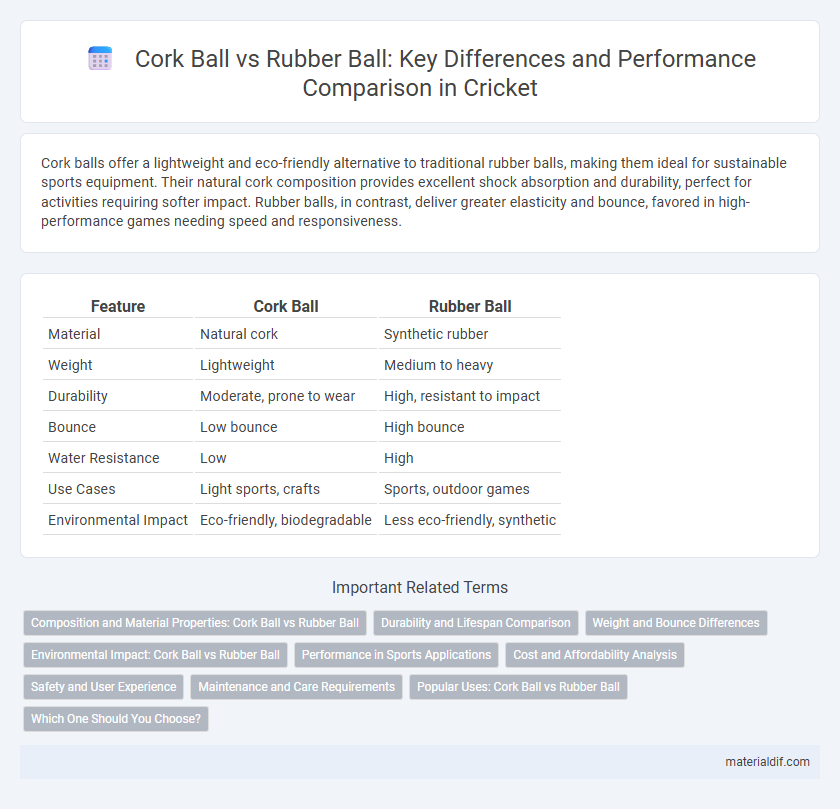Cork balls offer a lightweight and eco-friendly alternative to traditional rubber balls, making them ideal for sustainable sports equipment. Their natural cork composition provides excellent shock absorption and durability, perfect for activities requiring softer impact. Rubber balls, in contrast, deliver greater elasticity and bounce, favored in high-performance games needing speed and responsiveness.
Table of Comparison
| Feature | Cork Ball | Rubber Ball |
|---|---|---|
| Material | Natural cork | Synthetic rubber |
| Weight | Lightweight | Medium to heavy |
| Durability | Moderate, prone to wear | High, resistant to impact |
| Bounce | Low bounce | High bounce |
| Water Resistance | Low | High |
| Use Cases | Light sports, crafts | Sports, outdoor games |
| Environmental Impact | Eco-friendly, biodegradable | Less eco-friendly, synthetic |
Composition and Material Properties: Cork Ball vs Rubber Ball
Cork balls are composed of natural cork material, known for its lightweight, compressibility, and excellent shock absorption, making them ideal for sports requiring gentle impact. Rubber balls are made from synthetic or natural rubber, offering higher elasticity, durability, and resistance to wear and tear, suitable for fast-paced games. The material properties of cork provide a softer touch and lower bounce, whereas rubber delivers greater rebound and resilience under various playing conditions.
Durability and Lifespan Comparison
Cork balls exhibit exceptional durability due to their natural elasticity and resistance to deformation, often lasting significantly longer than rubber balls under similar conditions. Rubber balls tend to degrade faster when exposed to harsh environmental factors like heat and moisture, leading to cracking and loss of bounce over time. In terms of lifespan, cork balls are favored in sports such as baseball for their consistent performance and extended usability, whereas rubber balls may require more frequent replacement.
Weight and Bounce Differences
Cork balls typically weigh between 40 and 60 grams, making them lighter than standard rubber balls, which range from 120 to 150 grams. The cork material results in a lower bounce compared to rubber balls, which exhibit higher elasticity and rebound height. These weight and bounce differences significantly affect gameplay dynamics, with cork balls providing slower, more controlled movement while rubber balls offer faster, more reactive play.
Environmental Impact: Cork Ball vs Rubber Ball
Cork balls have a significantly lower environmental impact compared to rubber balls due to their natural, biodegradable material sourced from sustainable cork oak trees. Rubber balls, often made from synthetic or non-renewable rubber, contribute to pollution and landfill waste as they degrade slowly and release harmful chemicals. Choosing cork balls promotes eco-friendly practices by reducing carbon footprint and supporting renewable resource use.
Performance in Sports Applications
Cork balls offer superior shock absorption and reduced bounce, making them ideal for sports requiring controlled impacts like baseball training and cricket practice. Rubber balls provide enhanced durability and consistent rebound performance, favored in high-intensity sports such as tennis and handball. The choice between cork and rubber balls directly influences game dynamics, player safety, and equipment longevity.
Cost and Affordability Analysis
Cork balls generally cost more than rubber balls due to the premium natural materials and labor-intensive production processes involved. Rubber balls offer greater affordability and durability, making them a popular choice for budget-conscious consumers and high-usage scenarios. In Cork's local market, the price difference significantly impacts purchasing decisions, with rubber balls preferred for cost-effective sports and recreational activities.
Safety and User Experience
Cork balls offer enhanced safety due to their softer material, reducing the risk of injury during play compared to rubber balls, which are harder and can cause more impact-related harm. Users often prefer cork balls for indoor or casual games where minimizing damage to surroundings and participants is crucial. The lightweight nature of cork balls also improves user comfort and control, enhancing the overall playing experience.
Maintenance and Care Requirements
Cork balls require minimal maintenance due to their natural resilience and resistance to moisture, making them ideal for outdoor sports in varied weather conditions. Rubber balls demand regular cleaning and inspection to prevent degradation from dirt and sunlight exposure, extending their lifespan. Proper storage of cork balls in dry environments preserves their structural integrity better than rubber balls, which can crack or harden if not kept away from extreme temperatures.
Popular Uses: Cork Ball vs Rubber Ball
Cork balls are widely used in baseball training due to their lighter weight and reduced risk of injury, making them ideal for youth leagues and indoor practice sessions. Rubber balls, known for their durability and higher bounce, are popular in recreational sports like handball and street hockey, providing consistent performance on various surfaces. The distinct material properties influence each ball's suitability across different sports and training environments, with cork balls emphasizing safety and control, while rubber balls prioritize resilience and versatility.
Which One Should You Choose?
Choosing between a cork ball and a rubber ball depends on the playing surface and game type; cork balls offer lighter weight and less bounce, ideal for indoor or smooth surfaces, while rubber balls provide durability and higher bounce, suitable for outdoor or rough terrains. Cork balls reduce impact and are favored in sports like cricket and golf for precise control, whereas rubber balls excel in recreational games such as basketball and dodgeball due to their resilience. Evaluating the specific sport requirements and playing conditions will help determine the optimal ball choice for performance and safety in Cork.
Cork Ball vs Rubber Ball Infographic

 materialdif.com
materialdif.com